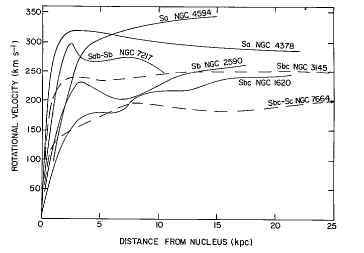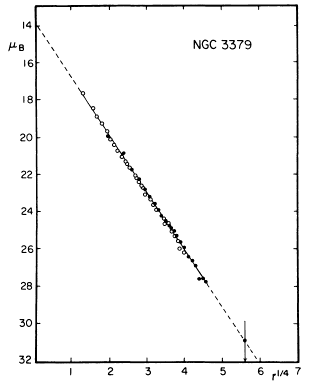| Physics 321 |
Astrophysics II: Lecture #20
|
Prof. Dale E. Gary
NJIT
|
The Nature of Galaxies
Classification of Galaxies
-
Tuning
fork: Zeilik Fig.21-1 -- Not an evolutionary diagram.
-
Elliptical galaxies: Designation En
where n = 10 (a - b)/a
-- e.g., E0, E5
-
Comparison of M32
(companion of M31Andromeda
Galaxy) and M87.
-
Using globular clusters to find distance
to M87
-
cD galaxies -- super-ellipticals with multiple
nuclei (cannibalism?)
-
Spiral
galaxies -- dust is key
-
Oddball galaxies
Characteristics of Galaxies
-
Zeilik Table 21-1 -- Mass Estimates from
Luminosity (visible matter)
Fundamental Characteristics
of Galaxies
| |
Ellipticals
|
Spirals
|
Irregulars I
|
| Mass (Msun) |
105 - 1013
|
109 - 4 x 1011
|
108 - 3 x 1010
|
| MV |
-9 to -23
|
-15 to -21
|
-13 to -18
|
| Luminosity (Lsun) |
3 x 105 - 1011
|
108 - 2 x 1010
|
107 - 109
|
| M/L (Msun/Lsun = 1) |
100
|
2 - 20
|
1
|
| Diameter (kpc) |
1 - 200
|
5 - 50
|
1 - 10
|
| Population Content |
II, old I
|
I arms, II halo/bulge
|
I, some II
|
| Dust |
None
|
Yes
|
Yes
|
| |
|
|
Sa
|
Sb
|
Sc
|
|
0.9
|
0.4-0.8
|
0.4-0.6
|
|
2
|
5
|
10
|
|
K
|
F to K
|
A to F
|
|
|
| Color Index (B-V) |
+1.0
|
+0.3 to 0.4
|
| MH I/M (%) |
~0
|
22
|
| Spectral Type |
K
|
A to F
|
-
The morphological mix
-
Observed (brightness limited):
77% spirals, 20% ellipticals, 3% irregulars
-
Space-limited sample (to 9.1 Mpc): 33%
spirals, 13% ellipticals, 54% irregulars
-
Galaxy colors/spectral types
-
Depends on morphology
-
Dominated by relatively few giant stars
-
Elliptical and early spiral -- K star spectra
-
Late spirals -- G or F star spectra, with
K spectra in central bulge
-
Invisible radiations
-
Radio
-- H I (21 cm line), H II (recombination lines), CO (mm lines) -- for Sc
spirals and Irr I galaxies, the H I is much more extended than the stars
-- almost double in radius.
-
IR
-- measures amount of dust in galaxy
-
X-rays
from M31 (ROSAT)
-
Galactic rotation curves -- mass estimates
from dynamics (dark matter)
-
Rotation Curves
-
Velocity Dispersion <v2>
= 0.4 GM / r 1/2 where
r
1/2
is the radius enclosing half the mass

A series of rotation
curves for spiral galaxies. (Figure from Rubin, Ford, and Thonnard (1978),
Ap. J. Lett., 225, L107.)
Theoretical Considerations
-
Implications of Classification Scheme
-
Brightness of bulge/nucleus different from
disks (r - 1/4
law for bulge, slower e - ar
for disk)
-
Halo part of spiral behaves like an elliptical

The surface brightness
profile of the giant elliptical galaxy NGC 3379 is well represented by
an r1/4 law. (Figure from de Vaucouleurs adn Capaccioli 1979,
Ap J Suppl, 40, 699.)
-
Degree of tightness of spiral arms correlates
with rate of star formation (more formation--less tight spiral)
-
Either star formation affects dynamical
evolution of galaxies or something else (dark matter?) affects both.
-
Amount of dark matter plays an important
role in distinguishing barred and unbarred spirals.
-
Mergers
and Interactions
-
More
merger animation
-
What is dark matter?
-
Dust? No--dust is visible in IR
-
Brown dwarfs? HW problem will investigate
that...
-
Black holes? Not enough X-ray binaries.
-
Later, will see that dark matter problem
only gets worse when we consider clusters of galaxies.
-
Dark matter is central problem in comprehending
the universe.
-
Hubble
Deep Field -- Lots of galaxies (HST)


